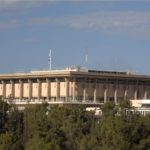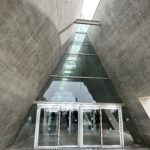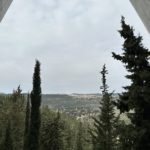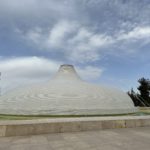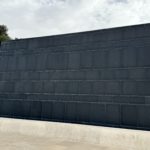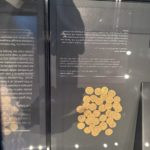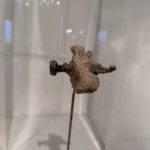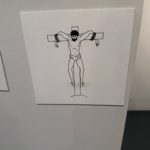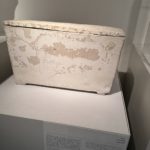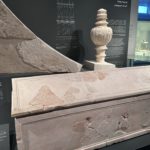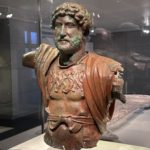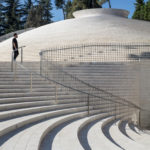
discriminatingly Mount Herzl’s Memorial: the National memorial for all soldiers who gave their lives establishing and defending the State of Israel
http://marionjensen.com/2016/03/i-like-you.html On our way to the museums, we passed “bureaucratic hill” where the Knesset, Israel’s Parliament, meets – which provoked a bit of discussion about Israeli politics. Mount Herzl is a high hill named after Theodor Herzl, the man considered to be the founder of Zionism, who is buried at the top of the hill. The slopes are a large cemetery, similar to our Arlington National Cemetery, where Israel’s military can be buried in the main military cemetery. The entrance was filled with young military persons out for a day of learning about their history.
 We visited the Yad Vashem, Jerusalem’s official museum of the holocaust remembrance. Its very name, taken from Isaiah, means a memorial and a name. It is an archive, research institute, and a monument to perpetuate the memory of the more than six million Jews who were killed during the holocaust. The entrance is along the Avenue of the Righteous Among Nations, which is lined with plaques bearing the names of 23,000 Gentiles who put their own lives at risk by helping Jews, including Oskar Schindler.
We visited the Yad Vashem, Jerusalem’s official museum of the holocaust remembrance. Its very name, taken from Isaiah, means a memorial and a name. It is an archive, research institute, and a monument to perpetuate the memory of the more than six million Jews who were killed during the holocaust. The entrance is along the Avenue of the Righteous Among Nations, which is lined with plaques bearing the names of 23,000 Gentiles who put their own lives at risk by helping Jews, including Oskar Schindler.

The dome in the Hall of Remembrance in Yad Vashem
Photos were not allowed inside the museum. Exhibits in the museum include 2,500 personal items donated by survivors. The Hall of Remembrance bears the names of 21 of the main death camps on flat, black basalt slabs. At the center is a casket of ashes from the cremation ovens. Above it is an eternal flame. The Hall of Names records the names of all those Jews who perished along with as much biographical detail as possible. We were guided by David, a museum guide originally from Baltimore, now living in Israel. Our tour lasted about 2 ½ hours as he recounted stories of the history of the rise of Hitler, Nazism, and the development of the “final solution to the Jewish problem.” Visitors are expected to dress appropriately – no shorts or miniskirts!
We had lunch at the restaurant at Yad Vashem, called Modern. We were served a first course of traditional Middle Eastern nibbles: hummus, quinoa, beets, roasted vegetables, pita quarters. The second course was chicken schawarma (dish that finds it roots in the Ottoman Empire) and an Arabic dish called upside down (eggplant, rice, vegetables, and shredded beef) – all served family-style.
After lunch we visited the Israel Museum one of the world’s leading museums of art and archaeology, where some of the Dead Sea Scrolls are displayed in the incomparable Shrine of the Book. The design of the shrine was inspired by the lids of the jars in which the scrolls were found. The white dome and the black basalt wall depict the battle between the Sons of Darkness and the Sons of Light described in the War Scroll. The jets of water symbolize the ritual purity of the community that wrote the scrolls.
Before we entered the museum, Michal gave us a history lesson as we viewed the Second Temple Model, which depicts the city in Jesus’ time. It is now in a open air location and easy to walk around and to view the model from many angles.
After our history lesson we entered the Book of the Shrine to see Dead Sea Scrolls – in 1947, a Bedouin shepherd discovered jars containing seven ancient scrolls. Over the next 20 years, fragments of some 800 more were found in 11 caves and the nearby settlement of Qumran was uncovered. The scrolls date to between the 3rd century BC and AD68, with some containing the oldest existing versions of biblical scripture. The main chamber under the dome, reached after passing through a long passageway with an exhibition on life in Qumran, contains a facsimile of the Great Isaiah Scroll, the only biblical book that survived in its entirety. Its 66 chapters were written on strips of parchment, sewn together to be 23 feet. one of the display cases contained part of the real scroll.
On the Shrine’s lower level, is the 10th century Aleppo Codex, the oldest complete Bible in Hebrew.
We had some time remains so we spent about 30-minutes in the archeological section, and saw of the three Bronze busts of Emperor Hadrian (one is in the Louvre, and one in the London Museum), we Also saw Herod’s Tomb and a burial box with an ankle bone with a spike through it indicating additional crucifixions were more common than thought.


